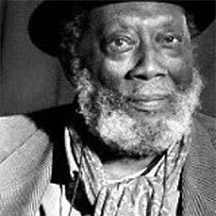After years of trying and many times being ignored, a Guyanese-born British artist finally gained commercial success after one of his ‘forgotten’ paintings sold for £185,000 in New York recently.
According to the UK’s Telegraph, Frank Bowling’s painting Polish Rebecca which had been “rolled up and forgotten in a friend’s attic for 40 years, was sold at New York’s Armory Show for US$275,000 (£185,000), far in excess of his auction record of £12,000.”
The report described Bowling as an “artist who has spent his life in poverty” who finally struck it rich at 79.
But even though he may have taken a while to strike gold in the world of art Bowling also created history by being a first for Blacks in the world of art in the UK. An exhibition at the Serpentine Gallery in 1986 was the first recognition he received by a public gallery in London. In 1987, Tate bought one of his paintings, its first work by a living black British artist. In 2005, he became the first black artist to be elected a Royal Academician.

The report said success has been a long time coming for the artist, who left Guyana for London in 1953. After a few false starts, he enrolled as a student at the Royal College of Art alongside the likes of David Hockney, RB Kitaj and Allen Jones, all of whom enjoyed success early on. But Bowling struggled, unable to find an effective gallery to sell his work.
The Telegraph said some of his struggles may have been due to the fact that he was West Indian and as Bryan Robertson, the director of the Whitechapel Art Gallery, said in 1964: “England is not ready for a gifted artist of colour.”
When pressured to exhibit at the First World Festival of Negro Arts in Senegal in 1966, Bowling “freaked. I began to feel I was being isolated from my peers because I was black. It seemed that everyone was expecting me to paint some kind of protest art out of post-colonial discussion. I resented being pre-packaged, as though put in a trick bag, and I had to fight my way out.”
His way out, according to the report, was to go to America. “I was largely ignored and not really understood in London, whereas the US enabled me to grow and change,” he was quoted as saying in the Telegraph.
In America he embarked on a series of “map paintings” – colourful abstract works rooted in ambiguous references to the South American and African continents, before freeing himself from figuration altogether with colour-saturated, entirely abstract painting.
According to the report, although Bowling never set out to become an American artist, he was adopted as one, and a black American at that. Against the background of the Civil Rights movement and growing cultural pressures, the Whitney Museum of American Art embarked on a series of exhibitions for black American artists, one of which was for Bowling in 1971. The Telegraph said for this historically unprecedented event he made a series of large “map paintings”, including the 11ft-wide Polish Rebecca, “where the ghostly, greenish-blue map of South America is drenched in oceans of sprayed, stained and soaked colour.”
The painting was titled after his friend, Polish-born Rita Reinhardt and was reproduced on the cover of the Whitney catalogue, in which Bowling declared there was no such thing as “black art”.
After the exhibition, the painting was taken off its stretcher, rolled up and sent to a friend in England, where Bowling had returned to be with his extended family.
There, Bowling eked out a living through occasional sales and teaching and he received occasional acknowledgement Commercial success continued to elude him; he was not represented by a UK gallery until in his seventies. Since then, several have shown his work – mainly the Rollo gallery in Fitzrovia, central London, and most recently the Hales gallery in Shoreditch, east London, which now represents him.
Hales director Paul Hedge, who sold Polish Rebecca two weeks ago, told the Telegraph that Bowling is the most important black artist of his generation, has been desperately undervalued, and that museums should have more of his work. His first exhibition for Bowling in 2011 coincided with an exhibition of his works on paper at the Royal Academy’s Friends Room, the publication of a monograph by Mel Gooding, and a room at Tate Britain devoted to his first purely abstract paintings of the 1970s.
Hedge says Bowling is being revalued along with a number of black American artists, in relation to British abstract painters such as Patrick Heron and John Hoyland, and the younger contemporary artists he shows.
Hedge has now sold quite a few paintings in the £40,000 to £60,000 range, but this is the first time he has priced one of Bowling’s works so high and sold it. Polish Rebecca is an exceptional example from a key period in Bowling’s life, he says; its sale marks a new stage in his career.
